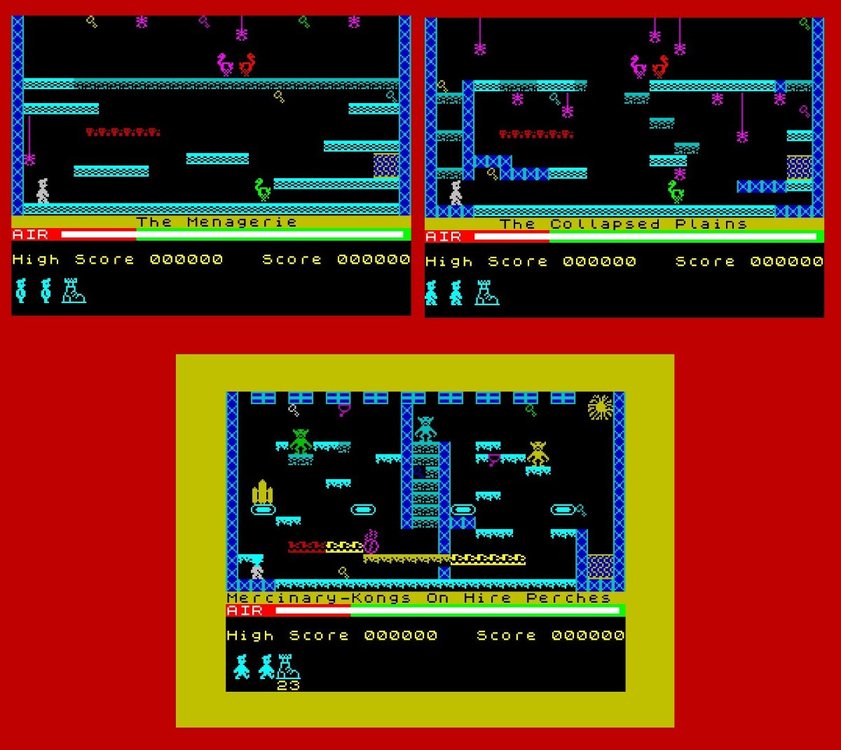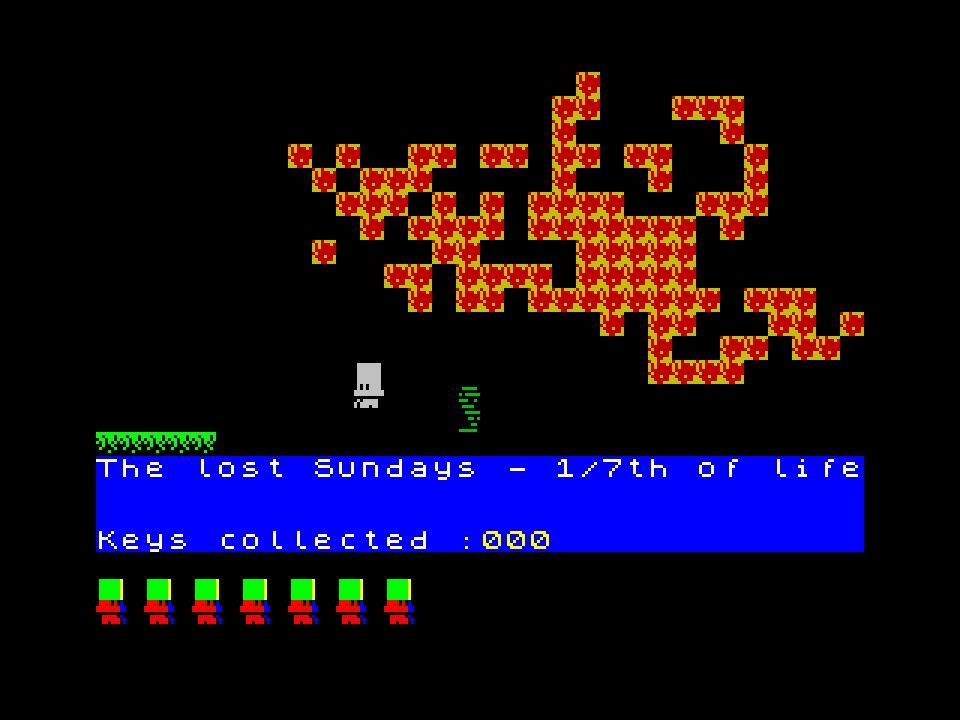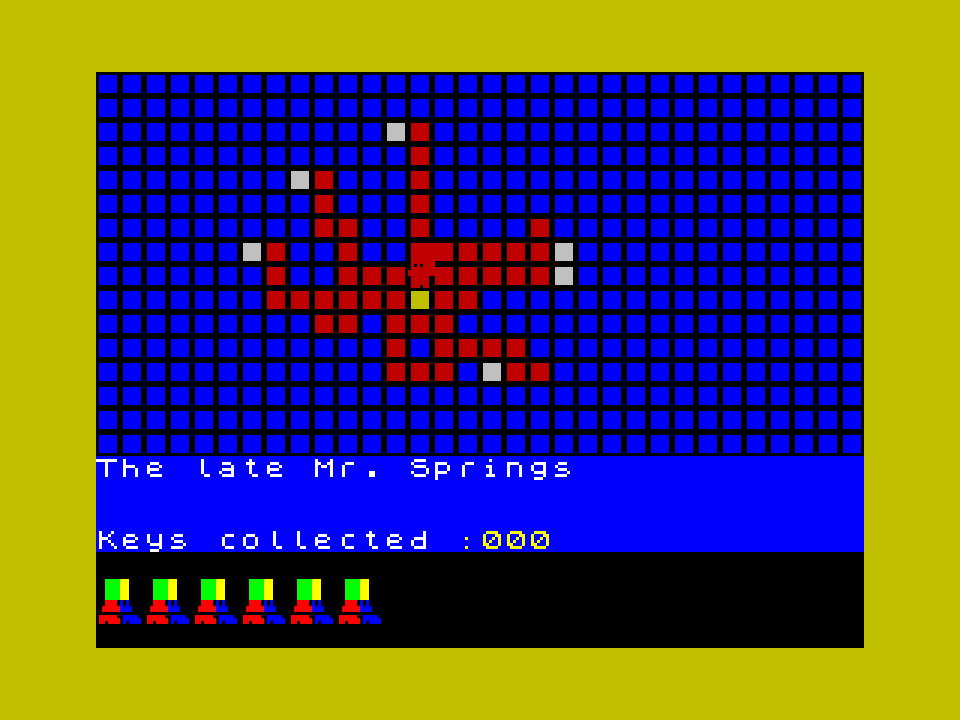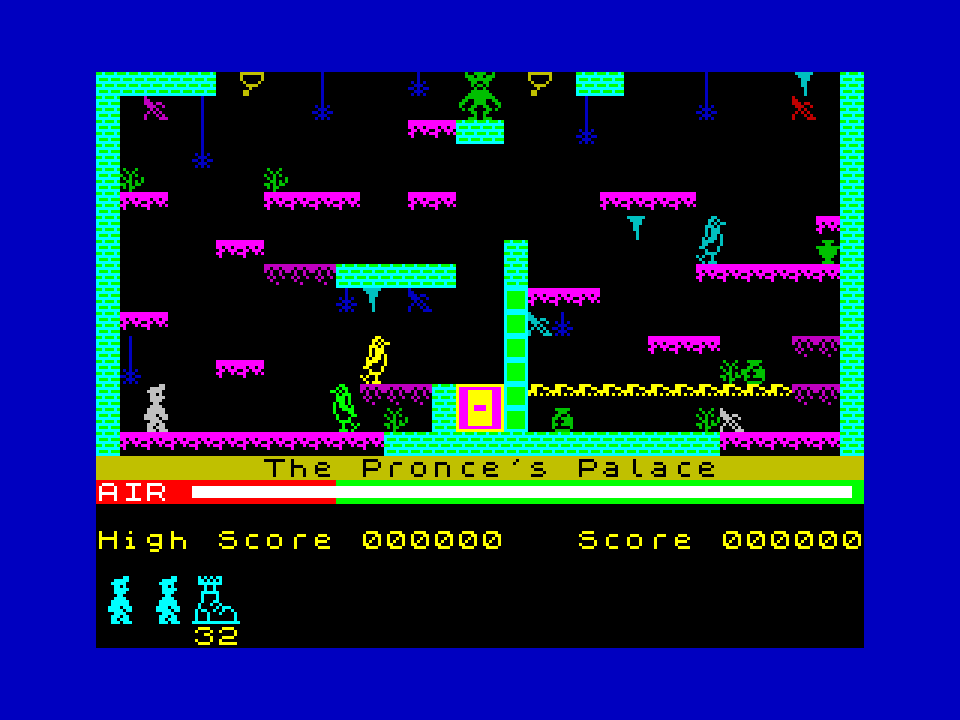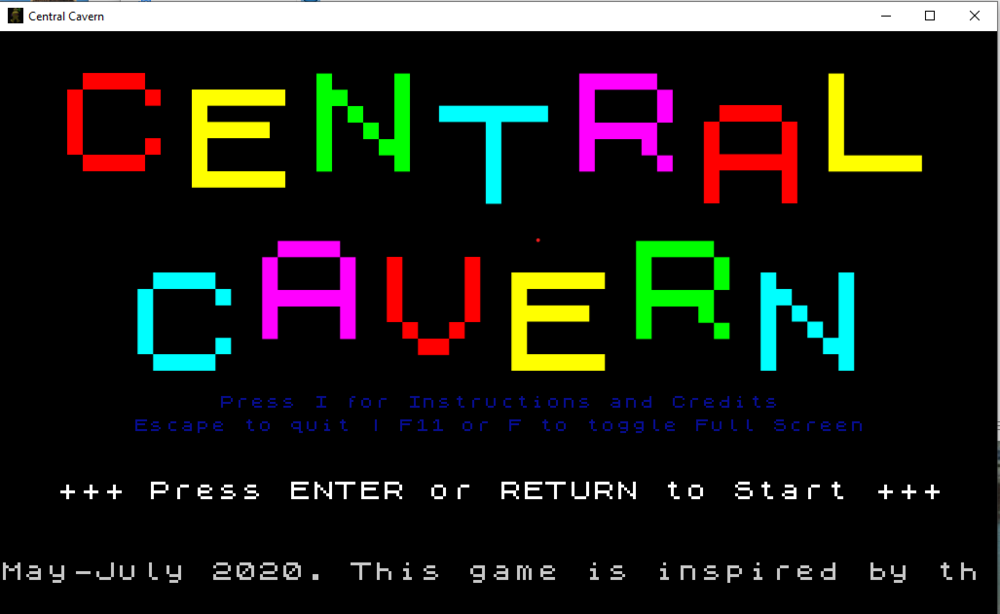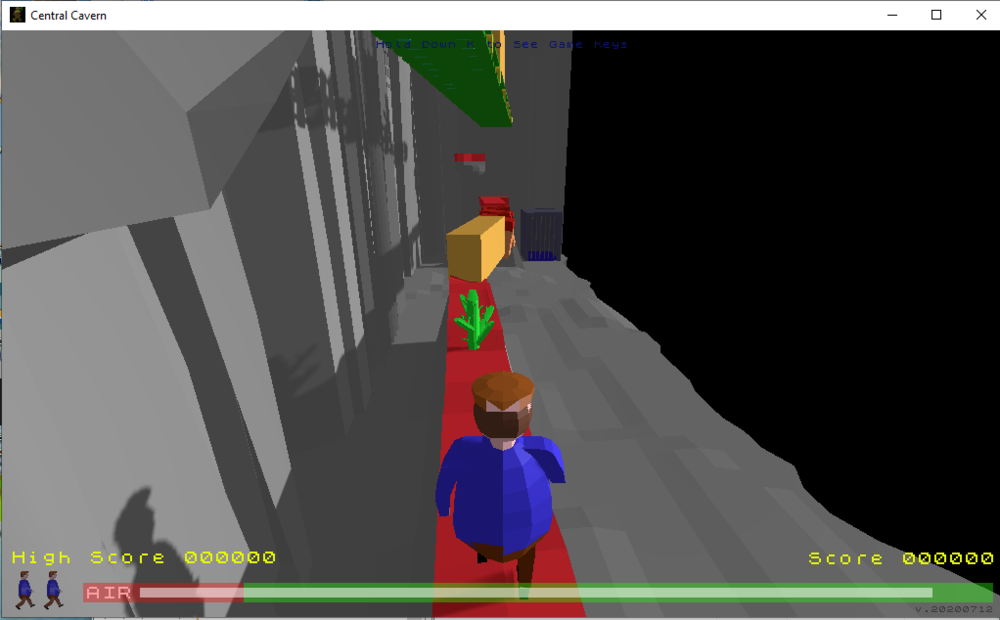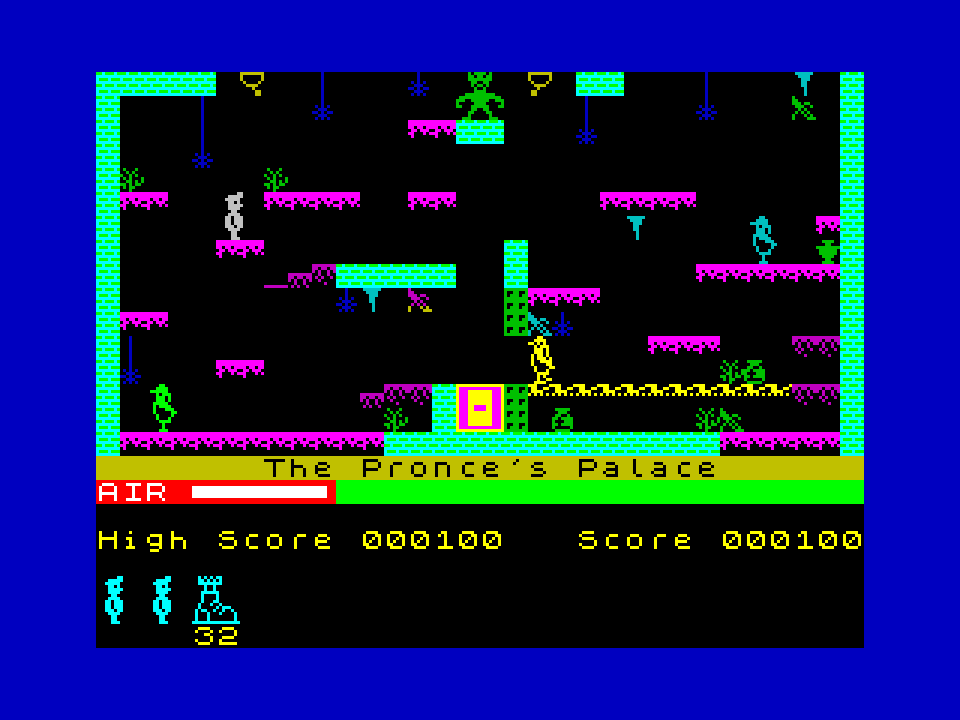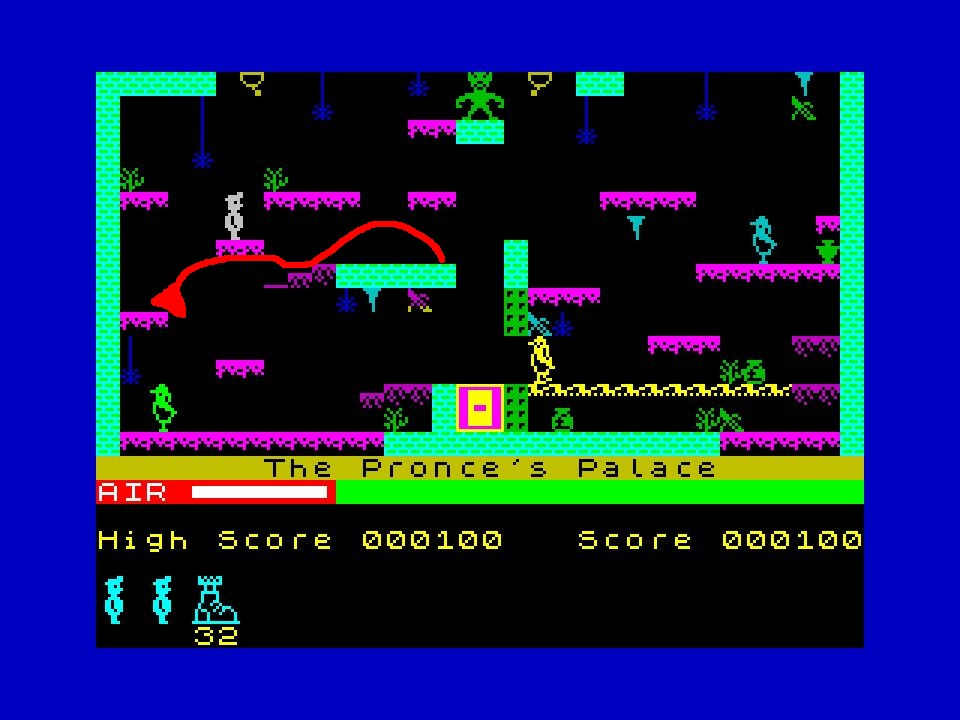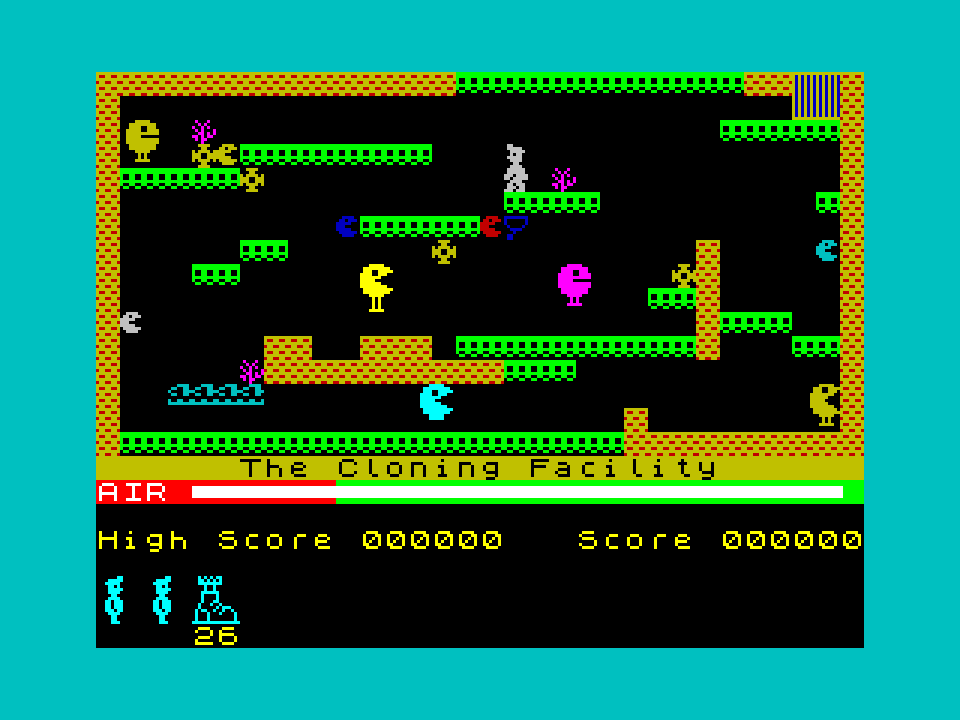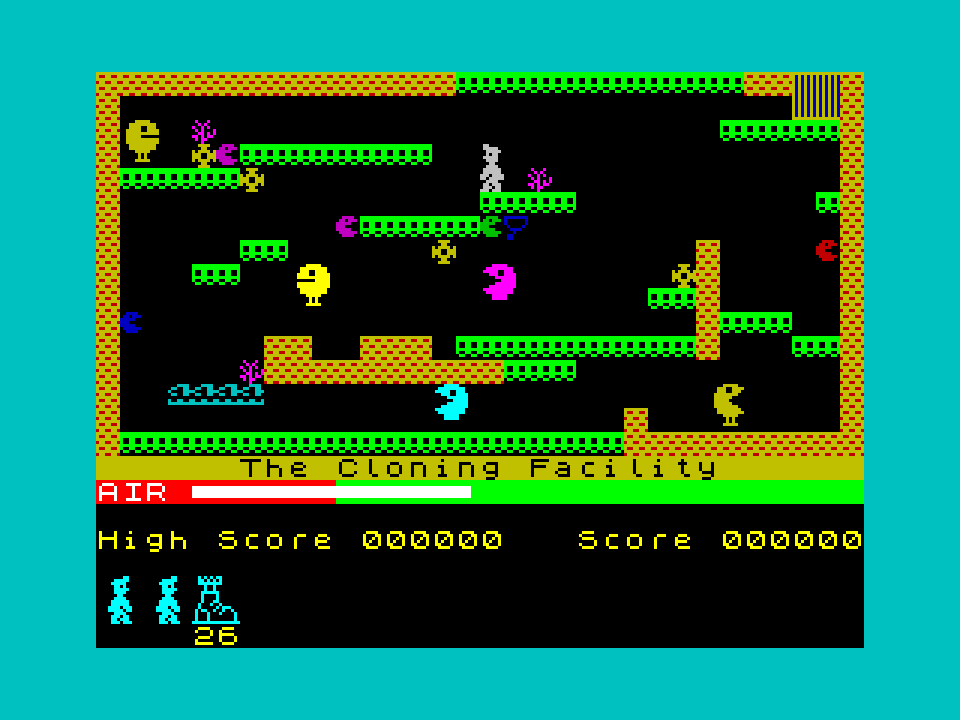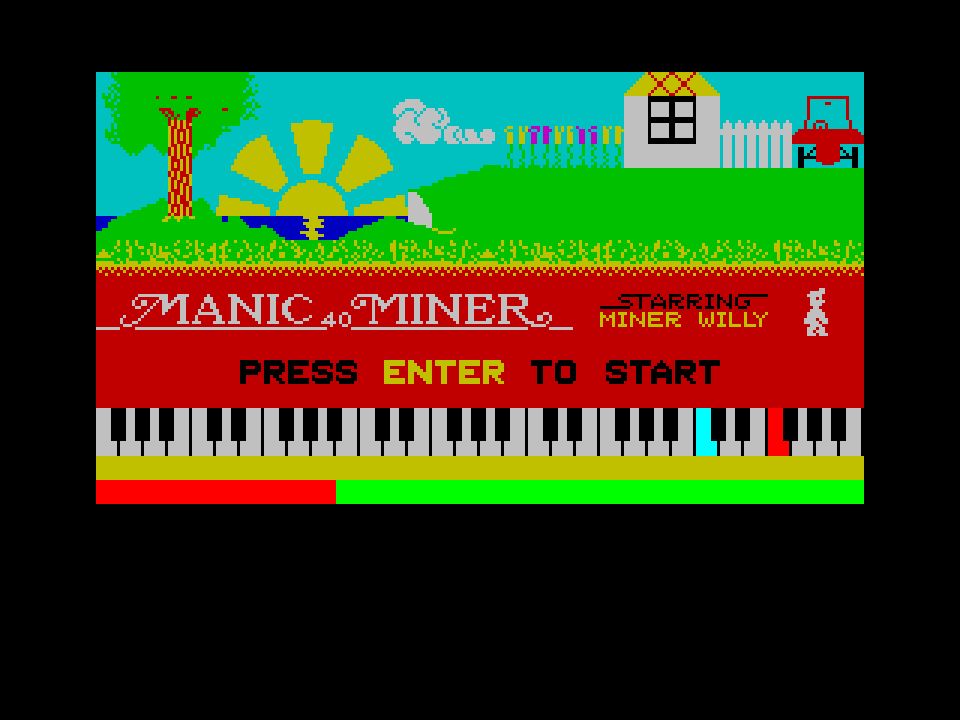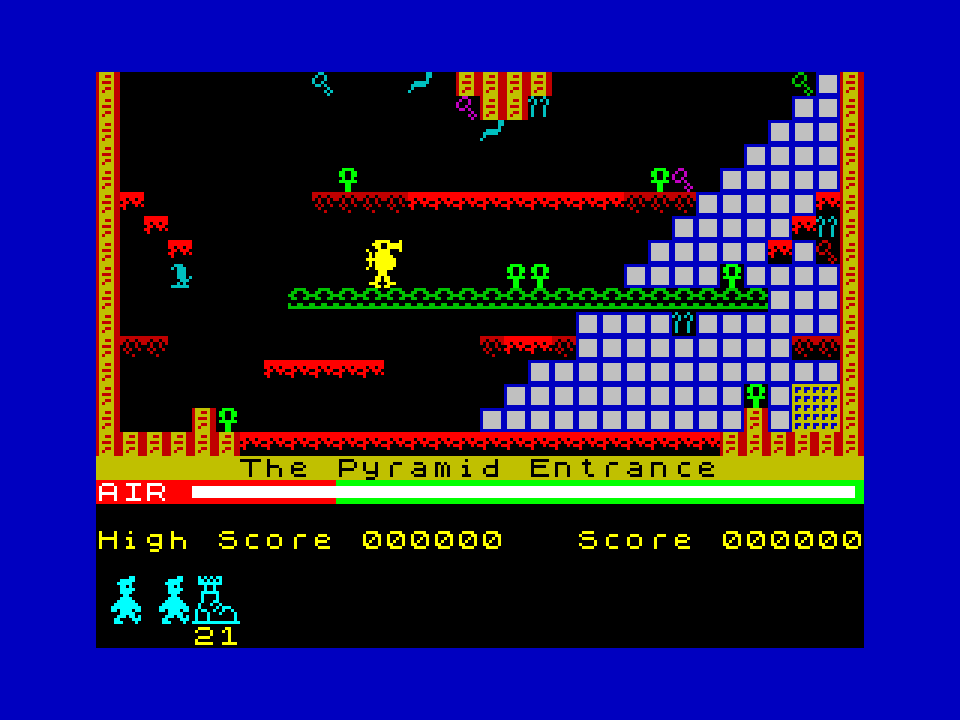-
Posts
618 -
Joined
-
Last visited
Everything posted by Norman Sword
-
Correction on the scope of editing done in Ligan's caverns. Ligans edit of the original Manic Miner 1) the sprites are not moved or recoloured or changed. The only exception is Eugene Which is a new definition. 2) the graphics for platforms/walls are 99% the original graphics. 3) some rooms/caverns change the graphic definition of the keys/items. 4) the start position in a few rooms/caverns is changed. 5) The graphic colours are not changed 6) The border colour is not changed. There might be exceptions to the above but the exceptions are trivial. Mercinary Kongs thus uses the graphics as provided by Matthew in the corresponding room. There are no Ligan graphics to use or in use.
-
Scope of editing the switches. In the original format the switches are fixed in position. To move the switch requires not an edit to the room graphics alone, but also an edit to the data for control of the switch. e.g. The game code itself needs editing. This restriction forces all switches for KONG style room to be placed in a fixed order and in a fixed position. Duplicating a room with KONG being a protagonist in the room. Also duplicates the position of KONG- the switches, the platform KONG falls off and the drop KONG does after the 2nd switch is flipped. Plus also the action of the erasure of the central wall and the sprite that passes through the wall. The above is a lot of fixed data and actions. I suppose its possible to write a routine to modify some of the above data to change its action. With a new routine for each and every set of data change. Not a very flexible method of allowing change. The switches. When I added a room editor I permitted the room data and therefore the switches to be edited. This change in itself necessitates re writing the whole of the room setup routine and a redesign of the KONG routine. Moving the switches with an editor means I need to track where the switches are, and unlike having routines that modify the code. I use the position generated by the room when drawn. These positions are stored and the routine for switch activation scans the list of stored switches. I did at one stage expand the switch routine to also expand the scope of what the switches did. For example having 3 switches and needing two switches flipped to activate wall erasure and the third to force KONG dropping. Surprisingly I scrapped the routine, simply because I could not be bothered having to explain the changes in logic that would follow. (That text would have been part of the editor's instructions. I would have needed the full explanation, yet most of the changes could not be edited (so from an editors point of view pointless)) The NEW sprite data The sprite data for KONG now stores its platform position (x,y) its distance of fall, its definition its colour and also the x,y position of the wall erasure. So I can edit most aspects of KONG in the source sprite listing. This means I can greatly change what the KONG routine does, without having to change any of the games code. So it has (for me) become a simple matter to place switches anywhere and have various sprites act on the switches. Seen in Manic Panic in the Final room. Alas the data for Manic 40 Miner uses the basic movement data of the original sprites in most of the rooms/caverns ( twice * 20 caverns) . So since the ability to change the parameters of KONG and the other sprites is NOT included in the editor, the extra features are rarely seen. The only extended version of KONG seen is Mercinary-Kongs on Hire Perches Cavern 23.
-

Suggestions for Christmas-themed Miner Willy games
Norman Sword replied to jetsetdanny's topic in Remakes
Chritsmas part Duex. Screen walk across on my pc is around 14 seconds. If the screen walk across is a slow 62 secs then it might be finishable by Christmas. I was looking for information on specific game modifications when I found these novelties. -

Suggestions for Christmas-themed Miner Willy games
Norman Sword replied to jetsetdanny's topic in Remakes
The version I listed here has been relisted later on- I will delete this listing - as now not needed. -

Suggestions for Christmas-themed Miner Willy games
Norman Sword replied to jetsetdanny's topic in Remakes
I am running windows 10 pro (x64) I downloaded the file (the one included above) and extracted to a new folder. The program runs, full window with no protests. Screen shots are via photographs.... -

Suggestions for Christmas-themed Miner Willy games
Norman Sword replied to jetsetdanny's topic in Remakes
Christmas Theme. Just about Miner Willy related. Only tried about 3 rooms. Not shure of the scope of this game. It runs on a PC. JetSetWillyAVeryWillyChristmas2_PC.zip Christmas1 would not run on my machine so is not included. -

Manic Mission - Manic Miner / Impossible Mission mashup game
Norman Sword replied to Heracleum's topic in Remakes
The image was instantly recognisable, I even thought it was Imagine. The problem was, I only did a quick search for Imagine and not Imagine software. The result of the original quick search was negative. So I assumed it was not Imagine, and stopped looking. -

Manic Mission - Manic Miner / Impossible Mission mashup game
Norman Sword replied to Heracleum's topic in Remakes
As soon as I saw the picture I recognised it as one iconic old picture. That does not mean I can remember what it was from. If I remember they are grouped in front of a keyboard/monitor looking at a game ?? -
The original code was written over the period of a week. The original code was using most of the original routines. And was very limited in its changes to the bulk of game routines. As I needed more and more space for the editor, I edited the original routines to shrink their size. Changing music tempo. I had to re read the source code... I added a routine (which I can now just about remember) That set the tempo of the music to the length of the air bar. Played in the final cavern, but can/could be set to any room. It is evident the Manic Panic was written shortly after this. The room data follows the same layout and uses most of the graphics. The room data in this (Manic 40 Miner) is not greatly compressed, it is stored in nibbles. The data in Manic Panic starts off in the same plain format, but as the game is run, it is expanded out and then re compressed. The plain data is then discarded. The expansion and compression are as follows Start of game compression 1) hex nibble expand. 2) run line compress.3) move to buffer 4) repeat "0" compress and move to buffer To draw each room. 1) repeat "0" expand 2) run line expand 3) nibble translate 4) draw room -------------------------------- As stated elsewhere the Editor in Manic 40 Miner does allow easy copying of the data from the original Ligan rooms. Just load up the screens (Ligan's), copy the item/object position into the editor, and read of the data positions, and type into my source code... The above would have been a lot easier than editing the data that I had. Perhaps one day I will update the item/data to replicate the original. (just not this year) ------------------------------- I saw your rzx recording about 10 mins after you posted it. Some of the caverns, do need more items. Just to make visiting some areas, part of the room play. If Ligans original data is inserted, then that would probably be the case... Next year perhaps. ----------------------------- Food for thought.... I should have done a version without the cheat enabled by default. The editor would still be accessable after the cheat is typed in. The cheat code is%^%£^&%£$%$£% or maybe £!$!%("^%£%*(&(£ or is it %^&%£"^&*"^"&^ or perhaps %£$%£$$£$££%£% . Such a long time since writing the code to now, I have forgotten. Those codes are from a note file that is embeded in one file I have remaining. In any case the cheat code is not needed, unless the editor is deleted from memory. ---------------------------- I am glad you enjoyed playing. Next up is Manic 41 Miner, and its sequel Manic 42 Miner. And in the same series the prequel Manic 39 Miner. This could run for several years.😁
-
Jsw2 has sprites crossing each other. Jsw2 also only collision detects with Willy. Code wise JSW can not replicate the rooms in jsw2. Whereas JSW2 replicates JSW.
-
Assembles and runs on Brave / Firefox / chrome / edge /opera.
-
I have deleted every other version up to V6c6. The version chronology was v,v1,v2,v3 etc small updates in code V3,v3a,v3b etc. Updates only in data. V6c,V6c1,V6c2,V6c3 etc.
-
A more extensive scope/explanation of why I wrote the keyboard scanning program. When emulating the zx spectrum, it can sometimes not respond to certain keyboard key combinations. When I was writing various utilities and even playing games on the zx spectrum. I was constantly aware of key combinations that did not seem to work. The cheat combinations of JSW and Manic Miner are a good example of key combinations that on various emulators and various pc's. Seemed to not respond correctly. The problem varied between my various pc's and changed according to the keyboard used. The problem was big enough for me to investigate what the emulator on my pc was showing as a key press. If I am writing a routine that needs key presses then having an emulated pc that can not respond to those key presses becomes a big problem. For example Manic Panic uses "ASD" "SDF" and "DFG" as groups of keys that have an action that changes the game play. Those key combinations work on my pc. Yet IRF has stated they do not work on his PC. To find out what my PC says is being pressed as a key and passed through its hardware/software to an emulator etc I wrote the keyboard scanner. Running the keyboard scanner, does a constant key scan of every key on the spectrums keyboad and displays which keys are being pressed. This should show clearly any key combination. The spectrums hardware and the emulated spectrums hardware should not have any problems responding to any key pressed. The keys pressed will show up on the simulated spectrum keyboard. When I originally wrote the keyboard scanner, I was suprised to find that certain groups of keys would not respond, when more and more keys were pressed. Most of my keyboards attached to most of my Pc,s had one problem or another. They were fine with one or two keys but failed as the keycount increased. I changed my code to remove key combinations that did not work. As stated earlier the most commen multiple key press combination program I used was JSW and Manic Miner. Both of these programs failed the multi keypress test. Running my keyboard scanner showed the scope of the problem and which key combination did not work. It will be noted that every re-write of JSW and Manic Miner I have done. Does NOT use the multi keypress type cheat that is in the originals, mainly beacuse of the keyboard problem. ----------------------- I mentioned elsewhere (another post) that I had a keyboard that was configured with a reset on the keyboard. To overcome accidently pressing the keyboard reset, I bought a gaming PC keyboard. ----------------------- Every problem I used to experience with scanning multiple key presses on an emulated spectum disappeared. Running my keyboard scanning program showed that the problems of groups of keys, seemingly stopping the response of other keys on my emulated spectrum where gone. I can now press any combination of keys and they will all show up on my keyboard scanning program. ---------------------- Concerning Mr top Hat Running on an emulated machine. The problems described by your inability to press the combinations of keys in an emulated spectrum game. Are more than likely, the problem of your keyboard. Running the keyboard scanner will remove the game from the test loop and focus only on what the emulator is seeing. If the keyboard scanner I wrote allows those combinations of keys to be pressed then the problem is the game. If it does not show those combinations of keys being pressed then it is the keyboard you are using.
-
Did you try running the simple program I wrote, it will display keyboard scanning problems very clearly? Downloaded the game (Mr Top Hat) and pressed the cheat key combinations. Emulated on fuse. Off to bed - its 4.35am
-
Its 4am As they say "a picture is worth a thousand words" Just looking at the nice green and black wall, and the nice green and black bush(that is deadly to the touch). MMMMmmmm ... The wall is/was defined as a nasty, which is obvious when looking at it knowing it kills on touch. Very suprised it was not noticed earlier. Wall colour (part of the the part erased) colour changed. Final version - which can be played through all 40 caverns. Instructions and re listed in the first post Manic 40 Miner V6c6.tap
-
I was looking for information on a totally different matter. When I spotted this. It runs on a PC. From YorkshireKev. I have only briefly looked at the program. Its different ... central-cavern-windows.zip
-
Jetsetdanny said:- However, I don't know if it is possible to enter the long Writetyper codes for these rooms [654219 and 65439, respectively] on emulated keyboards (it's not possible in Spectaculator, as far as I can tell), and I don't have any way of checking it on the real hardware right now or in the foreseeable future. Hence, in the picture gallery I included these rooms as ones which can "probably be accessed by using the Writetyper cheat". If anyone should be able to verify this, I would be happy to correct the information on JSW Central. My response:- Problems scanning keys. Running my program https://jswmm.co.uk/applications/core/interface/file/attachment.php?id=7279 Shows I can (with my gaming keyboard - on fuse) hold any of the above key combinations. The difficulty being I can't hold the first (654219) set of keys and navigate the mouse to do a screen shot. I can with the smaller combination 65439.
-
Just walk off the platform. Just to the right and below the platform in question. Is a collapsing floor. Knowing it will collapse as you walk on it means that the initial jump upwards (at the beginning of the cavern) onto the collapsing floor. Must be followed by a right jump shortly after landing. This leaves enough remaining, to enable you to walk right from the problem platform.
-
Changing data =========== Changing conveyor directions - in some cases this also involved changing the graphic and the colours. The data for item/objects/keys was not copied from the original. (as is evident) Changes for V6c5 28 -- United... changed conveyor direction also added an item/object/key upper right. 29 -- germo... changed conveyor direction 31 -- Finding... moved item/object/key one block left 32 -- The Pronc... The switches, and their action. The switches are scanned on building a room. If the room if filled with switches, only the first two are active starting at the top left and moving right and down. For the purpose of completing this cavern and removing the confusion, the extra switch has been deleted. The problems with positions of item/object/keys. I have moved item/object/keys to mimic the original in this room. (all of) 36 -- I forgot.. item/object/key moved one left 37 -- Iron ...changed conveyor direction The others caverns/rooms are left alone---- ---------------- Item/Object/Keys where originally placed without the position data for the rooms. Conveyor data was not copied. so item/object/keys and conveyor direction are hit and miss. My primary concern was writing an editor - Which does allow 100% of the above to be corrected via the editor. But I suppose it is better to have a version that is playable, rather than have a version that needs editing before playing. The irony is that the editor does allow me to easily duplicate the data that was not copied from the original. Which might have been easier than editing the data that was present. v6c5 has been deleted v6c6 the final version is listed on the very first post
-
Very similar to the last download. (v6c3) I have moved the start platform right and Willies start position along with it. This has added the forced lap after collecting the last object. By making the jump from the start position onto the platform above impossible. But having the jump back onto the start platform now possible (from the tall right wall) - means the original route can also be changed. This version has been deleted - final version V6c6 is listed on the first post
-
Cavern 26 The Cloning Facility scope of editing. I am not changing the code, just the data. I am not aware of any memory available to edit the code. This means that an action caused by Eugene or Kong/Switch has to mimic/duplicate the action of the original code, and not have their actions/scope extended. Eugene just activates on last key/object collected - no deletes of wall etc Kong activates on switchs, which means the switch can be flipped at any time in any key/object collection order. This will erase a wall on switch activation. Whilst I allow the position of the wall to be specified. It will still modify a sprite. (To ignore the modification, I can place a blank sprite over the modified sprites slot.) Deleting the bush on the conveyor on switch activation (in the edits I did) changes the way it is played. So the easiest option is to move the offending key/object. Since I went through the code for the switch and how it activates, I did add the switch which does not change the collection order for all the other keys/objects--- Problem might be the time needed to collect all the keys/objects in the cavern. NOTE I HAVE NOT COMPLETED THIS CAVERN. (not attempted) Yet another version V6c3. --- (deleted only final version available) At a later date - the miner change versions prior to the final V6cX will be deleted Addendum :- if this needs to be more difficult and plenty of time left. Then I can/could place a nasty on the top platform to force another lap ---. (only the final version V6c6 is now available and is listed on the first post)
-
Which ever path you take grass hopper, the path behind will be closed. If version v6c2 is playable then the other versions will be removed.
-
Errors in data for Manic 40 Miner v6c Since this was the last version - I am not modifying code - but I will modify the data. Two versions - V6c1 and v6c2 - Take the path grass hopper. both versions add another platform above the portal. V6c1 removes the crumbling conveyor platform V6c2 Leaves the crumbling conveyors alone. The removal of crumbling conveyors was because I expected a graphic problem, Having jumped on a few in the room itself ( I added a few and tested what happened) I reverted back to the original crumbling conveyor platform. Files listed alongside the original V6c The path that is taken - will remove the path behind.
-
I have replaced the file V6c in the linked post above. Not aware of deleting . I did however edit the instructions page and remove all the blank lines and spaces. I will not edit this file for at least a year, probably never. What the file showed me was it would far simpler to write an editor in something like QBASIC64. I spent a couple of days doing a screen editor for manic panic in QBASIC64. It is a feasable thing to go further and write an editor for the whole game. With less effort I could write an editor for Manic 40 Miner. By doing it in qbasic64 I do not have any memory constraints. Whilst I looked at the question of writing an editor. I stopped myself from actually going further. The reason being the vast quantity of variables in Manic Panic that can be edited in one way or another. The prgram I wrote was just a few hundred lines of code. (actually 864 lines) Manic 40 Miner would be a lot easier, just not particularly interested in doing so.
-
Concerning Manic 40 miner. Response to the above questions about Manic 40 Miner 1) The version should be playable and finishable. I have/had no intention of creating a new version. The data started as an amalgamation of two sets of data (I think that is stated in the scrolling message). I then edited some of the screens and added a part editor..... The editor part, was what I was concentrating on, not the game part. Hence the statement it is a test routine. 2) No other versions are planned. It might actually be impossible to update. This year and last, I have suffered more crashed and corrupted hard drives and ssd's than in the previous 30+ years combined. Around four drives I think! (without specifically checking) 3) Ok ---- I have not seen the code for this version on any of my backup drives. It is possible that all the code is on a dead drive. Addendum - I have checked ... it appears I have the source code and the room source code/data. Last version I have assembled is version 6c. No immediate plans to update. I concluded that editing the game in z80 with the code as well is not the ideal way to do it.

